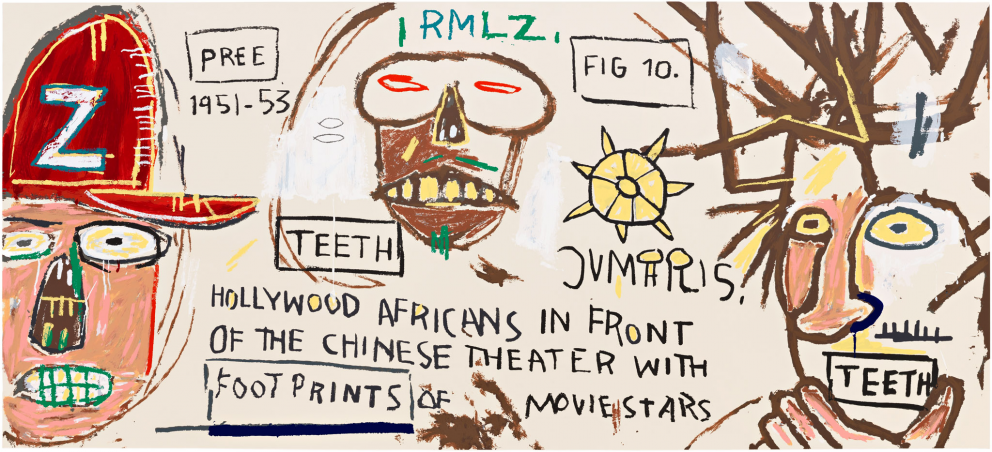The Estate of Jean-Michel Basquiat is pleased to announce the release of a new Basquiat screenprint, Hollywood Africans in front of the Chinese Theater with Footprints of Movie Stars, published by Flatiron Editions. The release marks the first edition authorized by the estate since 2005. It will be available exclusively through Pace Prints on October 21, 2015.
Orders will be accepted on a first come, first serve basis, starting Wednesday, October 21 at noon EST. Purchases can be placed in person at either Pace Prints location, or by sending an email with your name and telephone number to basquiat@paceprints.com. Orders placed before noon EST on October 21 will not be honored.
The edition of 60, which is related to the widely known 1983 artwork Hollywood Africans, owned by the Whitney Museum of American Art, depicts Basquiat with friends, the artists Toxic and Rammellzee. The subject of the work memorializes a time when all three artists were in Los Angeles during Basquiat’s second exhibition at the Larry Gagosian Gallery. The work, a commentary on the stereotyping and marginalizing of African Americans in the entertainment industry, led them to coin the term and refer to themselves as the “Hollywood Africans.”
Equal parts poet and painter, Basquiat challenged the art world binary of high and low, merging European and “primitive” through a neo-expressionist, painterly style that is nearly impossible to categorize. The posthumous release is stamped and signed by Lisane Basquiat and Jeanine Heriveaux, the artist’s sisters and administrators of the Estate of Jean-Michel Basquiat.
Full artwork information:
Hollywood Africans in front of the Chinese Theater with Footprints of Movie Stars
1983/2015 ∙ 23-Color Screenprint on 4-ply Museum Board
38 ½ x 84 inches ∙ Edition of 60
Jean-Michel Basquiat was born in Brooklyn, New York on December 22, 1960. He began his career making street art composed of enigmatic writings on buildings and walls in downtown Manhattan in the late 1970s. His work quickly rose to the spotlight, and by the early 1980s he gained the attention and acclaim of galleries and museums internationally. In what is often classified as a neoexpressionist style, Basquiat drew on social and political themes like systematic racism, identity politics and commodity culture. The artist died at the age of 27 on August 12, 1988 in his studio on Great Jones Street in New York City. Major exhibitions include “Jean-Michel Basquiat: Paintings 1981–1984,” Fruitmarket Gallery, Edinburgh (1984; traveled to Institute of Contemporary Arts, London; and Museum Boijmans Van Beuningen, Rotterdam, through 1985); Kestnergesellschaft, Hannover (1987, 1989); Whitney Museum of American Art, New York (1993; traveled to Menil Collection, Houston; Des Moines Art Center, Iowa; and Montgomery Museum of Fine Art, Alabama, through 1994); “Basquiat,” Brooklyn Museum of Art, New York (2005; traveled to Museum of Contemporary Art, Los Angeles; and Museum of Fine Arts, Houston, through 2006); and Fondation Beyeler, Basel, Switzerland (2010; traveled to Musée d’art moderne de la ville de Paris); and “Now is the Time” at the Art Gallery of Ontario (2015; traveled to the Guggenheim Bilbao in 2015).





